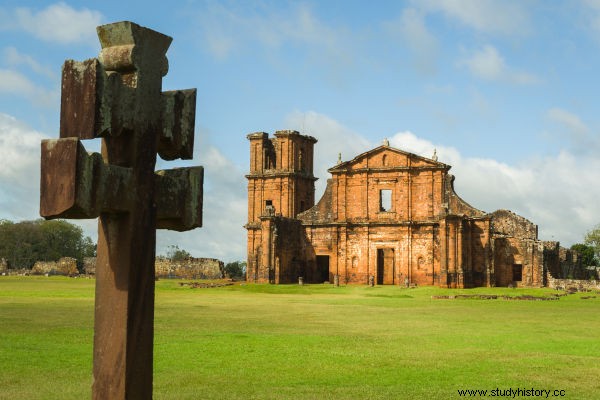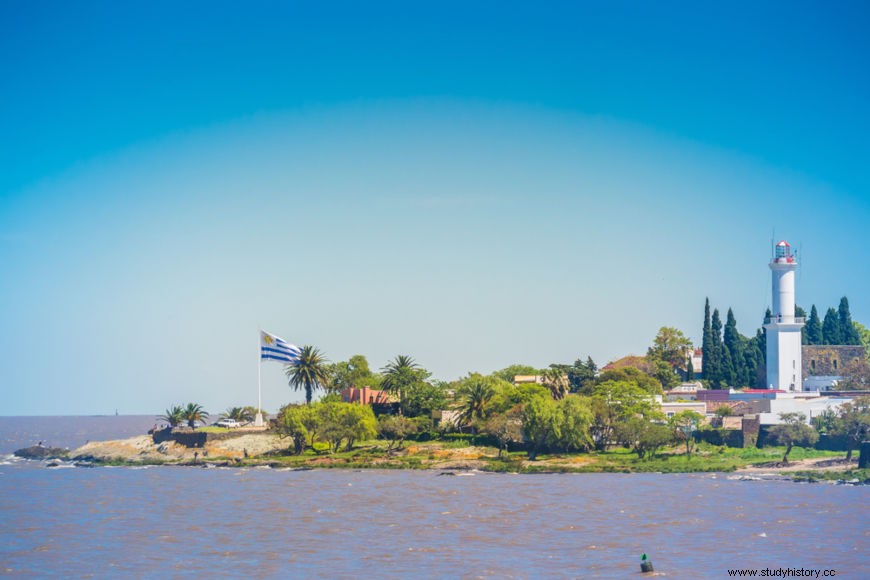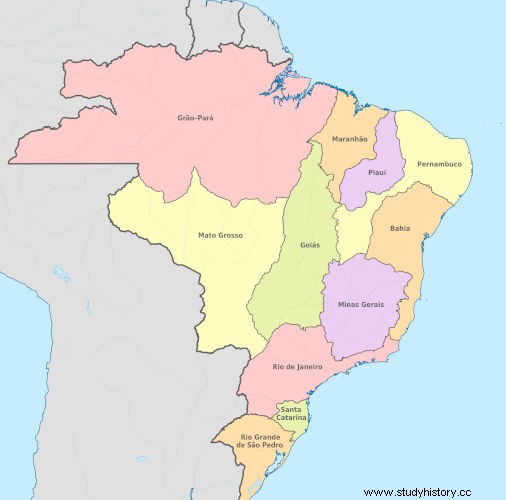
The Treaty of Madrid was a diplomatic agreement signed by Portugal and Spain on January 13, 1750. It was carried out to resolve territorial disputes that the two countries had since the end of the Iberian Union (16th century). Officialized the territorial expansion of Brazil and encouraged its population.
Also :Great Navigations and the European expansion
Summary on Treaty of Madrid
-
The division of land in America between Portugal and Spain was based on the 1494 Treaty of Tordesillas.
-
During the Iberian Union, borders practically ceased to exist, which contributed to the expansion of Portuguese settlers to the west.
-
One of the most disputed regions was the Colonia de Sacramento, which was located at the mouth of the River Plate, present-day Uruguay.
-
Alexandre de Gusmão was chosen by Portugal to defend Portuguese interests and made use of the principle of uti possidetis .
-
Portugal conquered vast lands in the Amazon and other regions in the interior of Brazil and gave up the Colonia de Sacramento and the Philippines.
What was the Treaty of Madrid?
The Treaty of Madrid was a agreement diplomatic signed between the kingdoms of Portugal and Spain, on January 13, 1750 . At the time, the kings were John V and Fernando VI , respectively. The treaty was a way to settle border disputes between the two countries in America .
This agreement was very important because it delimited, in general, a good part of the borders that delimit the Brazilian territory. In addition, he recognized that a series of territories occupied by the Portuguese, but belonging to Spain, would even belong to Portugal. It also consolidated the territorial expansion of Brazil.
Background of the Madrid Treaty

The issue of borders between Portugal and Spain dates back to the 1490, when the two countries signed, on June 7, 1494, the Treaty of Tordesillas , which traced a meridian 370 leagues west of Cape Verde. Through it, the lands west of the meridian would belong to Spain and the lands to the east would belong to Portugal.
From 1580 onwards, the Treaty of Tordesillas practically lost its validity due to the developments of the Iberian Union , the junction of the two Iberian crowns. This happened because the throne of Portugal was empty and the last king of the country had no direct heirs. This allowed the King of Spain Philip II to claim the right to the throne of Portugal.
In this context of joining the kingdoms, borders became useless, as everything belonged to Spain, although the colonial administration of Brazil was left in the hands of the Portuguese. During this period, Brazilian borders began to widen, as Portuguese settlers began to advance into lands west of the Tordesillas Treaty meridian.
This expansion was due to the formation of enterprises of the settlers in these lands, and there we highlight the creation of flags , the growth of activities livestock , especially in southern America, the formation of Portuguese colonies in the Amazon and the expansion dos Jesuits portuguese. However, the nerve center of this Portuguese territorial expansion was the south of America.
One of the points of great tension between Portugal and Spain was the issue of Colônia de Sacramento , founded in 1680 and located in the current territory of Uruguay, right at the mouth of the River Plate (on the opposite side of the mouth, was Buenos Aires). The Treaty of Lisbon, of 1681, for example, signed by Portugal and Spain, had defined that this colony would belong to Portugal.
The question of the dominion of the Colony of Sacramento continued to generate developments in the first half of the 18th century, and some agreements, such as the Treaty from Utrecht , were carried out to resolve this border dispute. Meanwhile, the Portuguese presence in places like Goiás and Mato Grosso increased considerably due to the discovery of gold.
Border issues, especially the dispute over the Colony of Sacramento, led Portugal and Spain to the negotiating table to define, once and for all, the borders between the colonies of these two countries in South America.
Login also :Avis Revolution and political stability in Portugal
Terms of the Treaty of Madrid
The 1740s were marked by diplomatic efforts by Portugal to try to resolve border disputes with Spain. The King of Portugal d. João V mobilized different people to negotiate the terms of an agreement, but they all failed. The accession of Ferdinand VI to the throne of Spain in 1746 allowed an agreement to finally be forged.
New negotiations were initiated, and Spain appointedJosé Car v ajal and Lancaster to guide the interests of the country. Portugal, in turn, nominated Alexandre from Gusmão , Brazilian very close to d. João V. Diplomat Miguel Paranhos de Rio-Branco stated that the appointment of Alexandre de Gusmão was intelligent because he had a great knowledge of Geography, of the Portuguese populations that lived in the south of America and of the economic possibilities of each place.| 1|
Alexandre de Gusmão decided that it was necessary to give up the Colony of Sacramento to guarantee the possession of another the s territories that could be more economically important , such as the lands of Goiás and Mato Grosso and the territories in the Amazon.
Thus, the idea was to consolidate the possession of these lands to the west for Portugal and use geography for the delimitation of borders. In addition, Gusmão was aware of previous treaties that determined that lands occupied by Spain, such as the Philippines, should be returned to Portugal.
He also used a principle of Roman law:the uti possidetis . In practice, this principle established that a land should belong to whoever occupied it, thus, many lands west of the meridian of the Treaty of Tordesillas should belong to Portugal because they were inhabited by subjects of that country. What would delimit the borders between the lands of Portugal and Spain would be great rivers or great mountains , for example.

One of Spain's interests, in turn, was to stop the Portuguese advance in the south of America and guarantee the total dominion of the estuary of the Plata . Thus, Alexandre de Gusmão's proposal was accepted and, on January 13, 1750, the Treaty of Madrid was drawn up. Portugal only ratified the treaty on January 26 and Spain on February 8.
Through this treaty, both countries acknowledged having violated the Treaty of Tordesillas and reached new resolutions:
-
The Colonia de Sacramento was handed over to Spain.
-
Spain took possession of the Philippines.
-
Portugal took possession of the lands crossed by the Amazon River.
-
Portugal also took possession of the land east of the Guaporé River, which is now part of Rondônia and Mato Grosso.
-
Portugal had its right over Sete Povos das Missões recognized.
-
Portugal was entitled to the lands that currently correspond to Paraná and Santa Catarina.
-
The treaty nullified all previous agreements between Portugal and Spain.
-
It determined peace between the colonies in South America, regardless of whether Portugal and Spain fought war in Europe.
-
It determined that the Spanish missionaries and the Guarani Indians should withdraw from the lands of Sete Povos das Missões.
Login also :Aleijadinho — one of Brazil's great colonial artists
Consequences of the Madrid Treaty
The Treaty of Madrid is understood as a grand d and diplomatic victory of Portugal , as the country managed to have its right assured over a vast territory in South America. Among the consequences of this treaty, the following stand out:
-
The definition of much of Brazil's current borders.
-
The dissatisfaction of the Spanish Jesuits, expelled from Sete Povos das Missões, which resulted in the Guaranitic Wars.
-
The treaty reinforced the Portuguese presence in the territories of present-day southern Brazil.
-
Reinforced the occupation of the interior of the Brazilian territory.
Note
|1| RIO-BRANCO, Miguel Paranhos. Alexander and the Treaty of 1750 . Brasília:Funag, 2010. p. 22.
Image credits
[1] Shadowxfox and Commons
